Greek Semolina Cake (Revani or Ravani) is a beloved dessert with a light, moist texture and a delightful sweetness. Semolina flour in this recipe gives the cake a slightly tender crumb and a subtle nuttiness. The cake batter is infused with a hint of citrus from the orange blossom water that brightens its flavor. The sponge cake is drenched with a fragrant lemon-sugar syrup that soaks and gives it a rich, refreshing flavor profile. Topped with lemon slices, a sprinkle of desiccated coconut and dried rose petals make it an irresistible indulgence that can be enjoyed with coffee, tea, ice cream, or frozen yogurt. It will become a favorite for special occasions and everyday moments!
This recipe is adapted from a recipe given to me by one of our Greek friends’ moms. She baked this cake at home and flew it with her in an airtight container while visiting her daughter, a student in Bristol, UK.
Revani or Ravani:
This Greek Semolina Cake, a dessert sponge cake, is called revani or ravani, ostensibly named for the Turkish poet, Ravani, who inspired this cake. It is traditionally made on festive occasions in Greece.
This sponge cake is made with semolina and coconut and showered generously with lemon-sugar syrup. While you can use orange syrup as an alternative, I prefer the fresh citrusy flavor of lemons as a tart counterpoint to this sweet, dreamy marriage between coconut and semolina. One bite into this cake will create an explosion due to the complex interplay between the ingredients.
Variations of the Greek Semolina Cake:
This recipe from our friend’s mom, which I had second and third servings, was richer than the version below. She adorned her cake with dried peaches and apricots. The cake was extremely moist, indicating she had copiously used lemon-sugar syrup. The lemon syrup moistened an otherwise dry cake and acted as a preservative for its relatively long journey.
I changed the toppings, using sugared lemon slices from the sugar syrup (which would have otherwise gone to waste). I reduced the amount of lemon syrup primarily because my family does not like it too sweet. You can add fresh fruit or even citrusy berries to add complexity to the flavor. There are variations of this sponge cake all over the Middle East called Basbousa.
Frequently Asked Questions:
- What Is semolina?
Semolina is a coarse, ground durum wheat flour. It is rich in protein, fiber, and vitamins and supports weight loss, heart health, and digestion while improving blood sugar levels.
2. Can I use olive oil instead of butter?
Some variations of this cake call for olive oil, so it is a good substitute.
2. What are the other toppings that can be used?
Some recipes use fresh fruits like peaches or even melons. However, melon slices on the cake will add sweetness and moisture.
3. How can I make this Greek Semolina Cake gluten-free?
While semolina is gluten-rich, there are alternatives, if you are allergic or prefer gluten-free options. To make it gluten-free, you can substitute semolina with almond flour for half the quantity of all-purpose flour. Semolina is a distinctive ingredient in this cake, but you can also substitute it with cornmeal.
This post may contain affiliate links. As an Amazon Associate, I earn from qualifying purchases at no extra cost to you.
If you’ve tried this recipe or have questions, I would love to hear from you. Please feel free to share (below) your thoughts, comments, or any questions that you might have. And if you like my recipes, you could subscribe to my mailing list for the latest recipes that will be delivered to your inbox. From my pen to your table, Bon Appetit!

Ingredients:
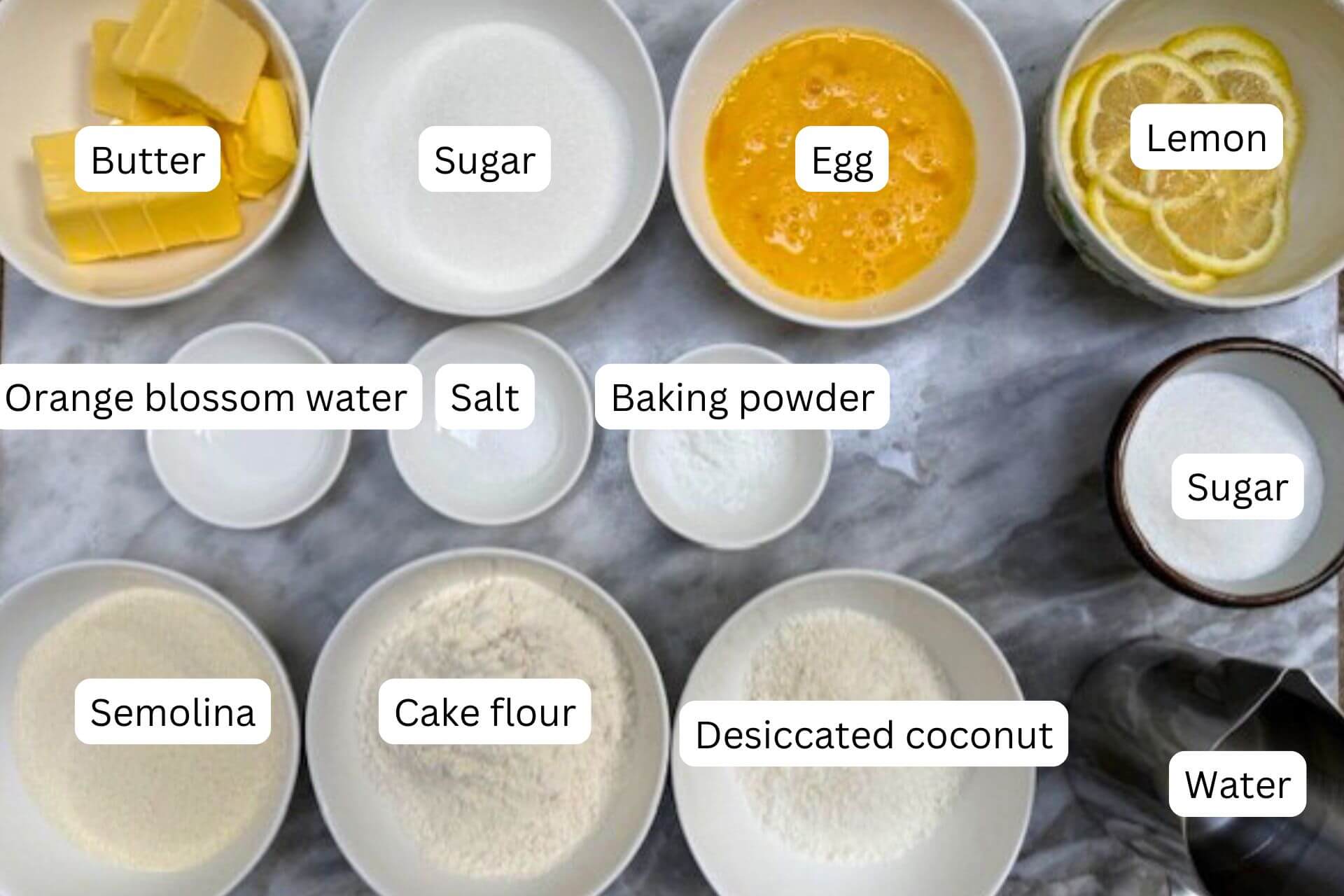
- Flour: semolina flour (or substitute it with cornmeal or almond flour), cake flour, and desiccated coconut
- Fat: unsalted European butter (or use olive oil)
- Flavoring: orange blossom water (or use orange zest and juice), lemon slices
- Cane sugar and eggs
Here are the step-by-step instructions on how to make this dish. Please refer to the recipe card below for the measurements.
How to make Greek Semolina Cake:
- Using a stand mixer fitted with the paddle attachment beat the butter and sugar until light and fluffy for 4-5 minutes.
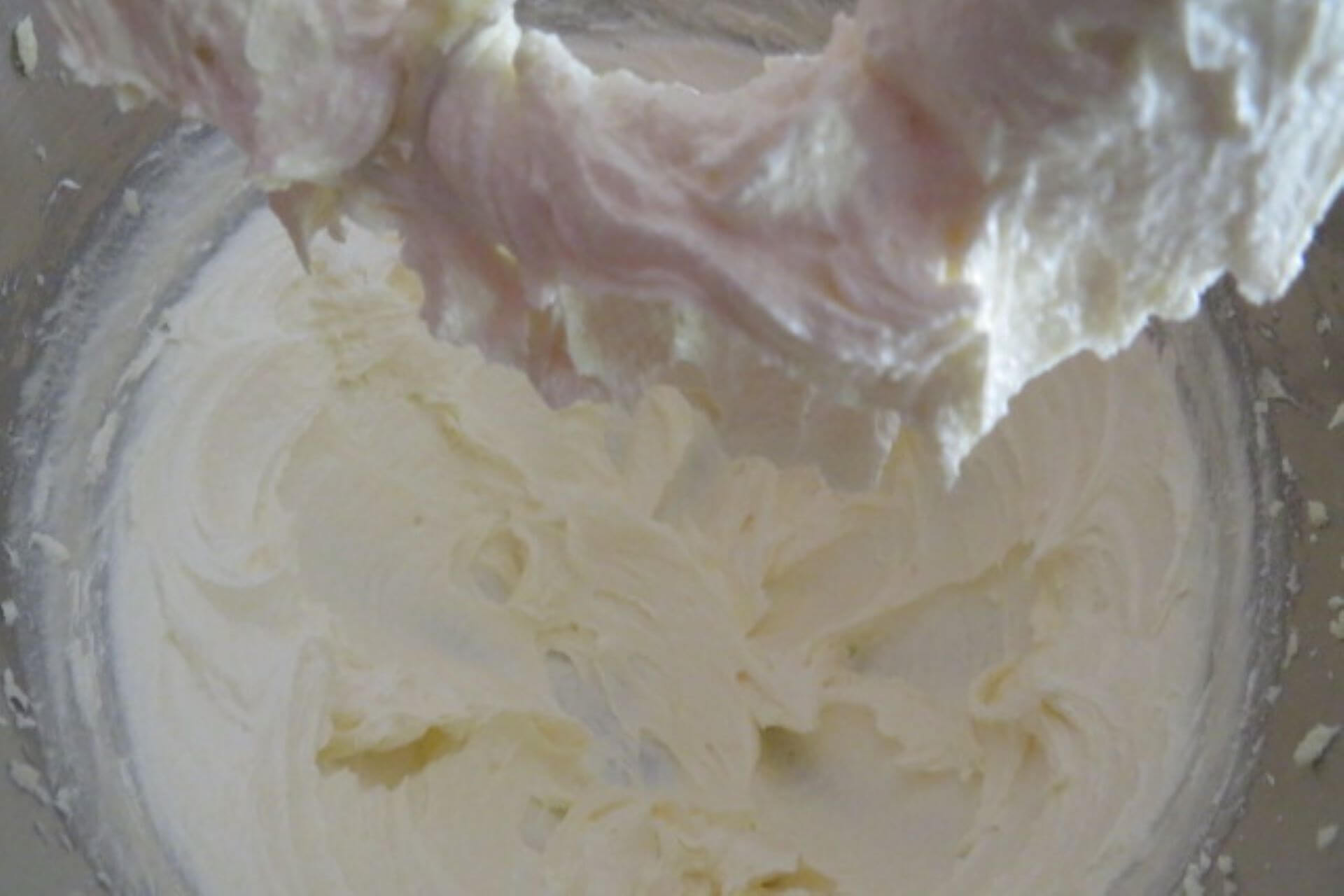
2. Gradually, add the eggs, beating well between each addition.

3. Add the orange blossom water and semolina and beat for 2-3 minutes. Fold in the desiccated coconut and cake flour sifted with salt and baking powder and stir until combined.
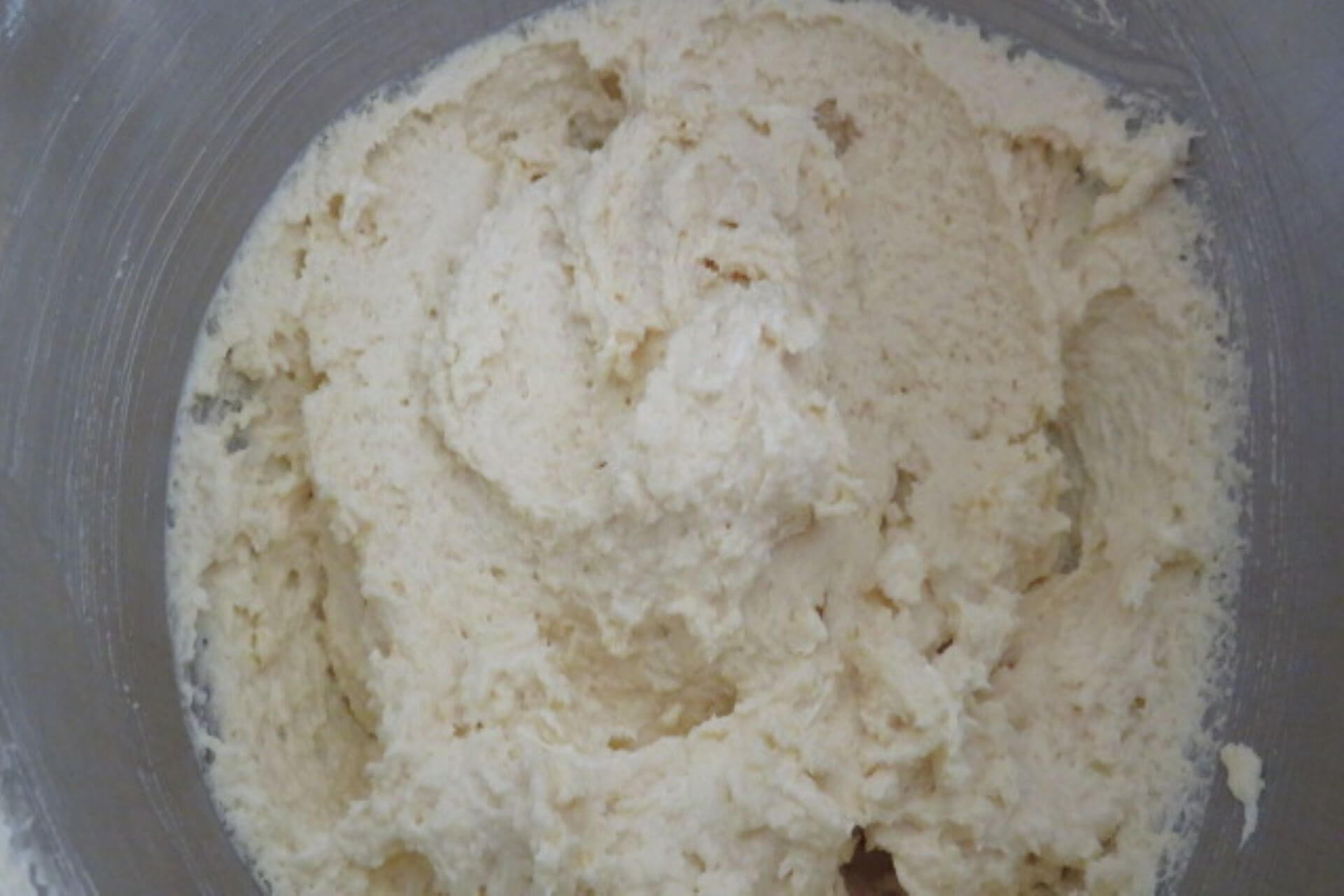
4. Spoon the batter into the prepared cake pan. Smoothen the top with a palette knife.
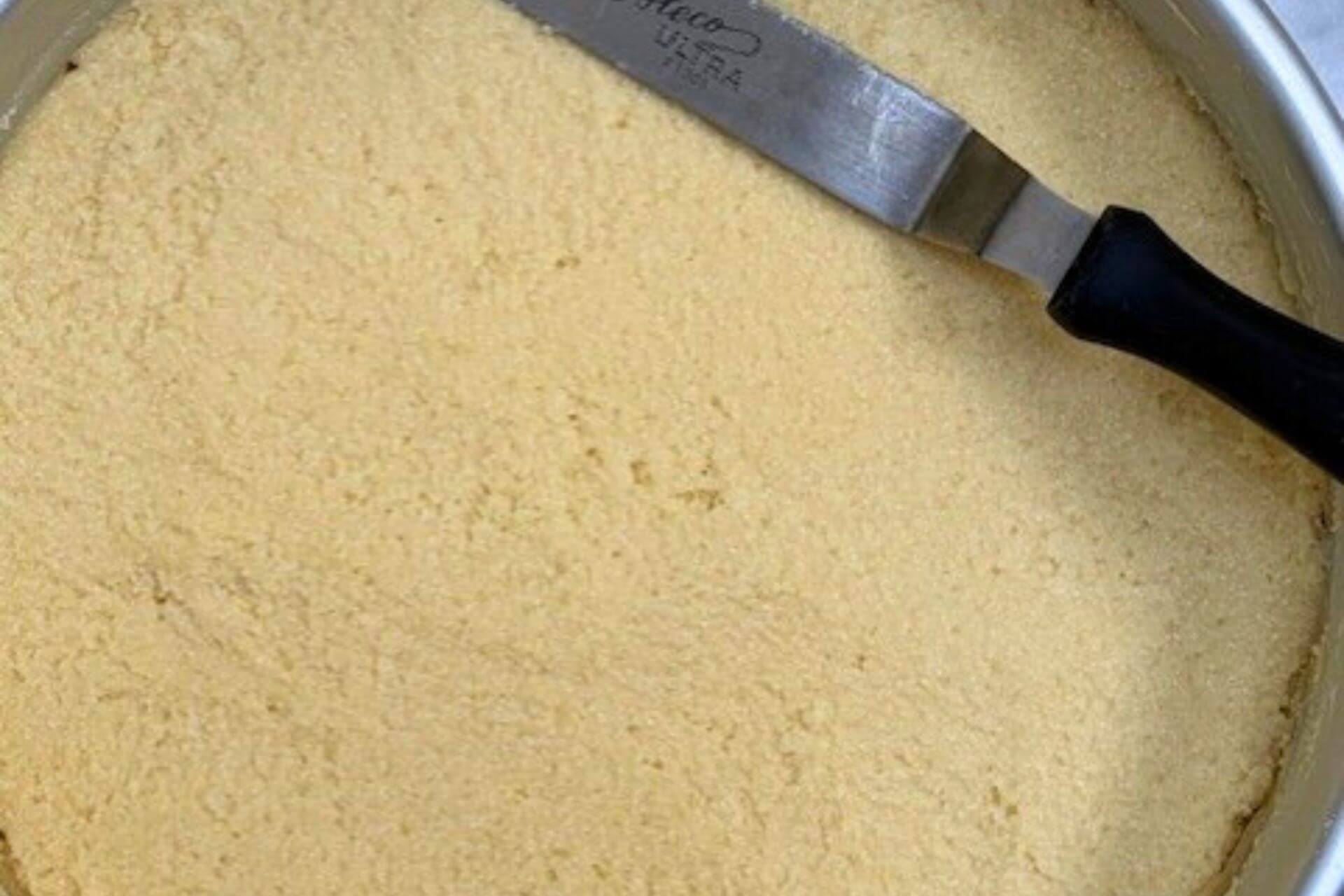
5. Bake for 40 minutes or until the cake tester comes clean.

6. Add water and sugar to a saucepot and stir until dissolved over low heat. Add the lemon slices and simmer uncovered for 16 minutes without stirring.

7. Drizzle the lemon syrup on the cake and garnish with the lemon slices.

Tips:
- The Greek Semolina Cake can be made ahead of time and refrigerated. Prepare the lemon-sugar syrup and drizzle it on the cake before serving.
- If using freshly grated coconut for this recipe, the cake can be refrigerated for 1-2 days. Desiccated coconut has a longer shelf life.
- Pour the lemon-sugar syrup on the cake while still hot, ensuring that you cover the entire circumference of the cake.
Serving suggestion:
Serve the Greek Semolina Cake garnished with lemon slices from the lemon-sugar syrup after pouring the syrup on the cake. Sprinkle a few dried rose petals and some desiccated coconut on top. Allow the cake to cool, set with the syrup, and serve it at room temperature, warm or cold. The cake tastes best when you pour the syrup on top and let the flavors meld for a 1-2 hours. You can enjoy this indulgent cake with coffee, tea, ice cream, or even frozen yogurt.
Storage:
The Greek Semolina Cake can be refrigerated in an airtight box for a week. You can freeze the cake for 3 months in a freezer-safe box.
Other dessert recipes that you might like:
Greek Semolina Cake
Equipment
- stand mixer, 6" springform pan, oven
Ingredients
For the Greek Semolina Cake:
- 4 oz unsalted butter
- ½ cup cane sugar
- 2 small egg lightly beaten
- ½ tsp orange blossom water
- ½ cup semolina fine
- ¼ cup desiccated coconut +1 tbsp
- ½ cup cake flour +2 tbsp
- ¾ tsp baking powder
- ¼ tsp salt
- 1 tbsp dried rose petal optional for garnish
For the lemon syrup:
- ¼ cup cane sugar +2 tbsp
- ½ cup water
- 1 lemon thinly sliced
Instructions
How to make the Greek Semolina Cake:
- Prepare the ingredients. Preheat oven to 350 degrees F. Grease a 6" round springform pan with half a teaspoon of melted butter and line with parchment paper.
- Using a stand mixer fitted with the paddle attachment beat the butter and sugar until light and fluffy for 4-5 minutes. Gradually, add the eggs, beating well between each addition. Add the orange blossom water and semolina and beat for 2 minutes.
- Fold in the desiccated coconut and cake flour sifted with baking powder and salt and stir until combined.
- Spoon the batter into the prepared cake pan. Smoothen the top with a palette knife.
- Bake for 40 minutes or until skewer comes out clean.
- Prepare the lemon-sugar syrup. Add the water and sugar to a saucepot and stir until dissolved over medium heat. Add the lemon slices and simmer uncovered for 10 minutes without stirring the pot.
- Remove the cake pan from the oven. Drizzle the lemon syrup evenly on the hot cake. Serve chilled or at room temperature garnished with the lemon slices from the lemon syrup, dried rose petals, and desiccated coconut.
Notes
Nutrition



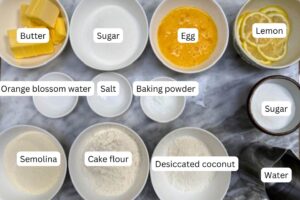

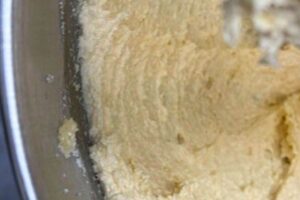
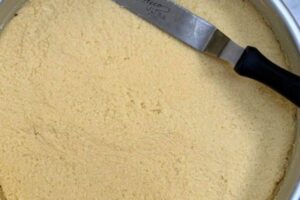
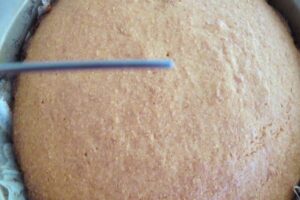






















Hi Kanchan!
I made this at home for my kids and they absolutely loved it! Thanks for sharing!
the semolina is a great ingredient!